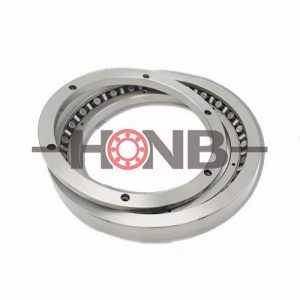30 reasons why bearings noise
Author: hongyuanTime:
1. There are impurities in the oil;
2. Insufficient lubrication (oil level is too low, improper storage causes oil or grease to leak through the seal);
3. The clearance of the bearing is too small or too large (manufacturer’s problem);
4. Impurities such as sand or carbon particles are mixed into the bearing to act as abrasives;
5. The bearing is mixed with water, acid or paint and other dirt, which will play a role in corrosion;
6. The bearing is flattened by the seat hole (the roundness of the seat hole is not good, or the seat hole is twisted and not straight);
7. The pad iron on the bottom surface of the bearing seat is uneven (causing deformation of the seat hole and even cracks in the bearing seat);
8. There are sundries in the bearing seat hole (residual chips, dust particles, etc.);
9. The sealing ring is eccentric (touching adjacent parts and causing friction);
10. The bearing is subject to additional load (the bearing is subject to axial tightness, or there are two fixed end bearings on one shaft);
11. The fit between the bearing and the shaft is too loose (the diameter of the shaft is too small or the adapter sleeve is not tightened);
12. The clearance of the bearing is too small, and it is too tight when rotating (the adapter sleeve is too tight);
13. The bearing is noisy (caused by the end face of the roller or the steel ball slipping);
14. The thermal elongation of the shaft is too large (the bearing is subject to static and indeterminate axial additional load);
15. The shaft shoulder is too large (it hits the seal of the bearing and causes friction);
16. The shoulder of the seat hole is too large (distorting the seal of the bearing);
17. The gap of the labyrinth seal ring is too small (friction with the shaft);
18. The teeth of the lock washer are bent (touching the bearing and rubbing);
19. The position of the oil throwing ring is not suitable (touching the flange cover and causing friction);
20. There are pressure pits on the steel ball or roller (caused by hitting the bearing with a hammer during installation);
21. The bearing is noisy (interference from external vibration sources);
22. The bearing is heated and discolored and deformed (caused by using a spray gun to heat and disassemble the bearing);
23. The shaft is too thick to make the actual fit too tight (cause the bearing temperature is too high or noise occurs);
24. The diameter of the seat hole is too small (causing the bearing temperature to be too high);
25. The diameter of the bearing seat hole is too large, and the actual fit is too loose (the bearing temperature is too high – the outer ring slips);
26. The bearing seat hole becomes larger (the non-ferrous metal bearing seat hole is enlarged, or becomes larger due to thermal expansion);
27. The cage is broken.
28. The bearing raceway is rusted.
29. The steel ball and the raceway are worn (the grinding process is unqualified or the product is bruised).
30. The ferrule raceway is unqualified (manufacturer’s problem).


We have rich experience on precision bearing manufacturing and are ranked NO.1 in China and NO.3 all over the world.
We can tailor the overall solution for the use of precision bearings.
HONB– Accountability & Innovation
Products
- YRT rotary table bearing
- YRTS rotary table bearing (high speed series)
- YRTM with integral angular measuring system series
- ZKLDF axial angular contact ball bearing series
- RA series crossed roller bearing
- SX series crossed roller bearing
- CRBH series crossed roller bearing
- RE series crossed roller bearing
- RU series crossed roller bearing
- RB series crossed roller bearing
- XR/JXR series crossed taper roller bearing
- Crossed roller bearing
Contact Us

✉️ bearing20@hyzcgroup.com
📞 +86 15236685001





